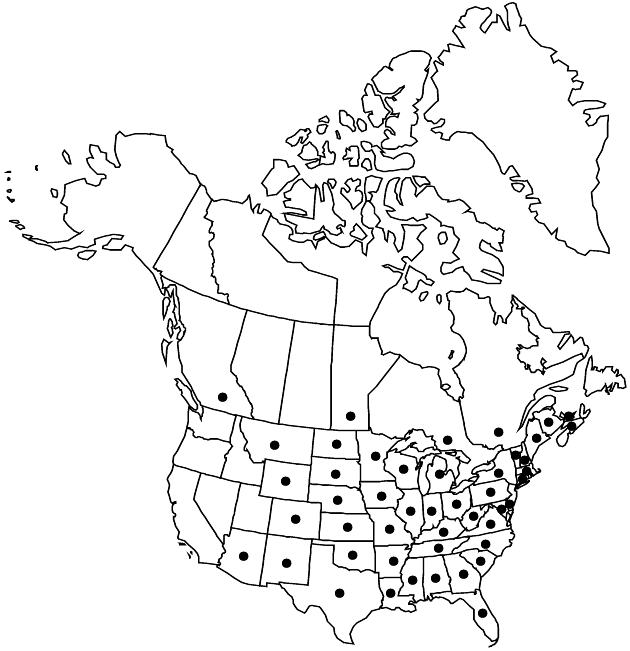Difference between revisions of "Rudbeckia laciniata"
Sp. Pl. 2: 906. 1753.
FNA>Volume Importer |
RevisionBot (talk | contribs) m (Bot: Adding category Revised Since Print) |
||
| Line 88: | Line 88: | ||
}}<!-- | }}<!-- | ||
| − | -->[[Category:Treatment]][[Category:Rudbeckia sect. Macrocline]] | + | --> |
| + | |||
| + | [[Category:Treatment]] | ||
| + | [[Category:Rudbeckia sect. Macrocline]] | ||
| + | [[Category:Revised Since Print]] | ||
Revision as of 17:16, 17 December 2019
Perennials, 50–300 cm (rhizomes often elongate, slender, plants colonial, roots fibrous). Leaves green, blades broadly ovate to lanceolate, all but distalmost 1–2-pinnatifid or pinnately compound, leaflets/lobes 3–11, bases cuneate to attenuate or cordate, margins entire or dentate, apices acute to acuminate, faces glabrous or hairy (sometimes with translucent patches); basal (often withering before flowering) petiolate, 15–50 × 10–25 cm; cauline petiolate or sessile, mostly lobed to pinnatifid, sometimes not lobed, 8–40 × 3–20 cm. Heads (2–25) in loose, corymbiform arrays. Phyllaries to 2 cm (8–15, ovate to lanceolate, margins mostly ciliate, glabrous or hairy). Receptacles hemispheric or ovoid to globose; paleae 3–7 mm, apices (at least of proximal) truncate or rounded, abaxial tips densely hairy. Ray florets 8–12; laminae elliptic to oblanceolate, 15–50 × 4–14 mm, abaxially hairy. Discs 9–30 × 10–23 mm. Disc florets 150–300+; corollas yellow to yellowish green (lobes yellow), 3.5–5 mm; style branches 1–1.5 mm, apices acute to rounded. Cypselae 3–4.5 mm; pappi coroniform or of 4 scales, to 1.5 mm.
Distribution

North America.
Discussion
Varieties 5 (5 in the flora).
Cultivars of Rudbeckia laciniata are grown as ornamentals. The cultivar ‘golden-glow’ is widely planted and occasionally escapes cultivation. Among the varieties traditionally recognized in floristic treatments, vars. ampla and heterophylla are the most distinctive. Detailed investigation may show that the other varieties, from eastern North America, represent broadly intergrading forms that should be subsumed under var. laciniata.
Selected References
None.
Lower Taxa
Key
| 1 | Receptacles ovoid; discs (17–)20–30 mm; w of Great Plains | Rudbeckia laciniata var. ampla |
| 1 | Receptacles globose or hemispheric; discs 10–20 mm; Great Plains and e United States | > 2 |
| 2 | Basal and proximal cauline leaves not lobed, adaxial faces moderately to densely hairy; Levy County, Florida | Rudbeckia laciniata var. heterophylla |
| 2 | Basal and proximal cauline leaves lobed, adaxial leaf faces sparsely hairy or glabrous; e North America (not Levy County, Florida) | > 3 |
| 3 | Proximal leaves usually with 0, 3, or 5 lobes; se United States | Rudbeckia laciniata var. digitata |
| 3 | Proximal leaves usually 1–2-pinnatifid or with 5–11 lobes; e North America (not se United States). | > 4 |
| 4 | Proximal cauline leaves 2-pinnatifid, mid cauline leaves 5–11-lobed; paleae 3.1–4.1 mm; cypselae 3.5–4 mm; pappi 0.7–1.5 mm | Rudbeckia laciniata var. bipinnata |
| 4 | Proximal cauline leaves pinnatifid, mid cauline leaves 5–9-lobed; paleae 4.4–6.1 mm; cypselae 4.2–6 mm; pappi 0.1–0.7 mm 7e. Rudbeckia laciniata var. laciniata | undefined |